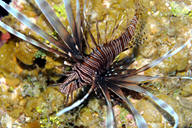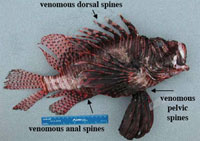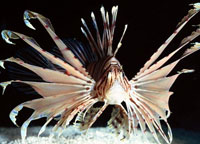WANTED DEAD OR ALIVE!


Many may have seen Pterois miles before and may not have realized it. The Pterois miles is a popular aquarium fish because of its beautiful stripes and coloration. To aquarium owners, they are well liked but many organizations around the Atlantic are trying to control the spread of these fish. It may look nice but be careful. People familiar with this fish call it the Devil firefish. The nasty name may not seem appropriate for such a nice looking fish, but as you will find out soon, it is capable of injecting a painful venom into predators and divers.
Introduction
The devil lionfish is an important fish to know about because of the profound effect it has on ecosystems all over the Caribbean Atlantic region. To fully understand everything there is to know about P.miles you need to be able to identify this organism apart from other species. The information can be found on the Nomenclature page as well as other information regarding its unique classification. Secondly, it is important to be aware of where P.miles lives. This can be found on the Habitat page. You may already be able to see some of the adaptations of this organism, but to learn how it uses these adaptations to its advantage can be found on the Adaptations page. These adaptations help the devil firefish to stay alive and produce offspring. To find where the devil firefish fits into the food web, click on the Nutrition page. In the case of this organism, understanding the reproduction and lifestyle of an organism can be extremely important in controlling the population. To read, about the lifestyle and reproduction simply visit the Reproduction page. By using all of this information, you will be able to fully understand how lionfish made it into the Atlantic Ocean and why it poses such a huge threat to local ecosystems. To read, about invasive lionfish visit the Atlantic Lionfish page.
photos taken from NOAA.gov
Site created by Lucas Belmore. Last updated on April 19th, 2013.
Please take time to visit MultipleOrganism.net and UW- La Crosse's homepage as well.
Thanks and enjoy!
Click on the Nomenclature button to go to the next page and read about Pterois miles names and classification.


